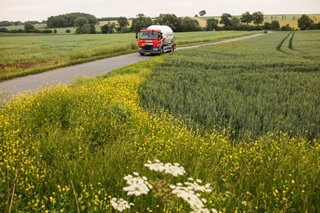What is BioLPG and Why is it the Future of Clean Energy?
Biological liquefied petroleum gas, or BioLPG, is a sustainable and renewable energy source made from organic elements such as waste fats, plant leftovers, and vegetable oils. BioLPG is produced using a process involving chemicals that turns renewable energy into energy, as compared with standard LPG, which is obtained from fossil fuels. This breakthrough fuel is ideal for Irish households and businesses wishing to reduce their impact on climate change since it has a significantly smaller carbon footprint while delivering the same efficiency and range as standard LPG.
With a growing emphasis on decarbonisation and the utilisation of renewable energy sources, BioLPG plays an essential role in the transition to clean energy. Ireland has set lofty climate goals, and BioLPG is well-positioned to help achieve them. BioLPG is compatible with existing LPG systems, so households and businesses may utilise it without requiring large infrastructure changes. BioLPG is being positioned as a fuel of the future owing to its ease of transition and environmental benefits.
How BioLPG is Empowering Rural Communities in Ireland
Oil, solid fuels and LPG have long been the sole energy options accessible to rural communities in Ireland, where access to natural gas networks is usually restricted. Despite their efficacy, these fuels have major environmental consequences and result in increased emissions. BioLPG provides a game-changing alternative that is both clean and sustainable, while yet maintaining dependability and performance.
One of the main advantages of bioLPG is its capacity to considerably reduce greenhouse gas emissions. Switching to BioLPG allows rural families to minimise their carbon footprint without changing their existing cooking or heating equipment. This is especially important in Ireland, where many rural areas rely on off-grid electricity.
BioLPG supports regional economies by supporting the development of renewable energy infrastructure.
BioLPG manufacture and distribution contribute to Ireland's economic growth and environmental objectives by creating jobs and promoting investment in green technology. It also allows farmers to convert agricultural waste into viable energy resources, which aligns with the ideas of the circular economy.
BioLPG: The Perfect Fuel Solution for Winter Heating
Ireland typically sees severe weather in the winter, so having reliable heating is essential for both comfort and security. BioLPG is the best winter heating option because to its consistent and efficient energy, which can power boilers, stoves, and central heating systems.
One of the most noticeable advantages of BioLPG is its reliability over the winter. Unlike electricity, which goes out during storms, BioLPG is a continuous energy source that keeps houses warm even in adverse weather. Furthermore, BioLPG burns cleanly, reducing interior air pollution and improving overall air quality—especially during the winter when ventilation is limited.
The environmental benefits of BioLPG are most obvious during the winter months, when consumption of electricity and output are high. Switching to BioLPG allows families and businesses to enjoy an appropriate temperature for each season while lowering their carbon footprint.BioLPG is a good option for Irish houses trying to strike a balance between sustainability and comfort.
BioLPG vs Traditional LPG: What’s the Difference?
Although BioLPG and conventional LPG have very similar functions and purposes, their sources and environmental consequences differ. Conventional LPG is made from fossil fuels, which are a finite resource that contributes to global warming. BioLPG is a cleaner and more sustainable option since it is derived from renewable feedstocks.
Both fuels are extremely adaptable and can be used for cooking, heating, and even powering automobiles. BioLPG, on the other hand, has significant environmental benefits because it is renewable. BioLPG allows Irish homes and companies to reduce their dependency on oil and gas without actively contributing to a healthy economy.
Carbon footprints are another significant distinction. BioLPG, compared compared to normal LPG, can cut lifecycle greenhouse gases by as much as 80 per cent. Because of this huge drop, BioLPG is an excellent option for anybody looking to comply with Ireland's environmental rules and climate goals.
It is similarly straightforward to convert from regular LPG to BioLPG. Because their chemical characteristics are similar, BioLPG and regular LPG may be utilised with existing devices and infrastructure without any modification. Compatibility encourages more people to switch to this cleaner energy source by making the transition easy and affordable.
Why BioLPG Matters for Ireland
Ireland is committed to achieving net-zero emissions by 2050, necessitating innovative solutions that combine utility and environmental sustainability. BioLPG is a great example of such a solution. BioLPG is a sustainable option to conventional fuels that bridges the gap between Ireland's long-term climate goals and present energy usage.
BioLPG's flexibility allows it to be employed in a wide range of applications, including residential heating and industrial processes. Its seamless integration into existing systems increases its attractiveness, particularly for off-grid houses and rural settings. As more individuals learn about the benefits of BioLPG, its use is projected to grow, benefiting Ireland's energy business.
In conclusion
BioLPG is the renewable energy of the future in Ireland. Its environmental benefits, interoperability with existing infrastructure, and ability to support rural populations make it a special solution to both immediate and long-term energy issues. By using BioLPG, Ireland might take a significant step towards a more sustainable and environmentally friendly future.
From questions about LPG and BioLPG to switching assistance, Calor is here to help – contact us today!




 }
}
 }
}
 }
}
 }
}
 }
}
 }
}
 }
}